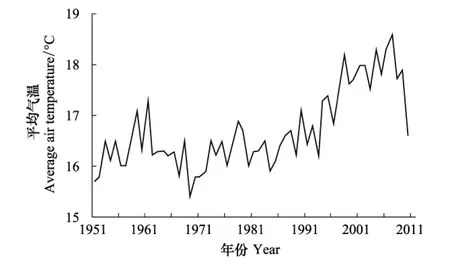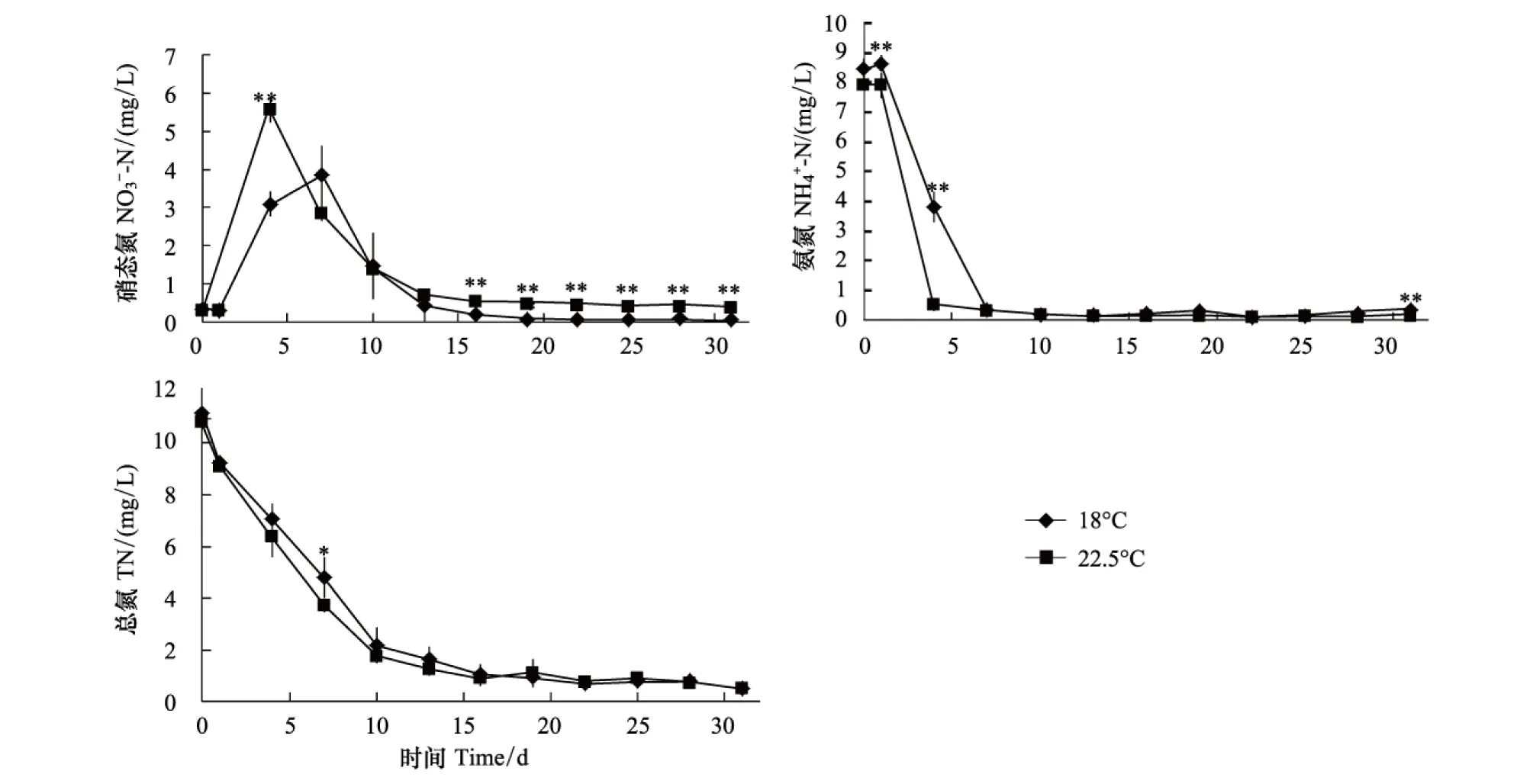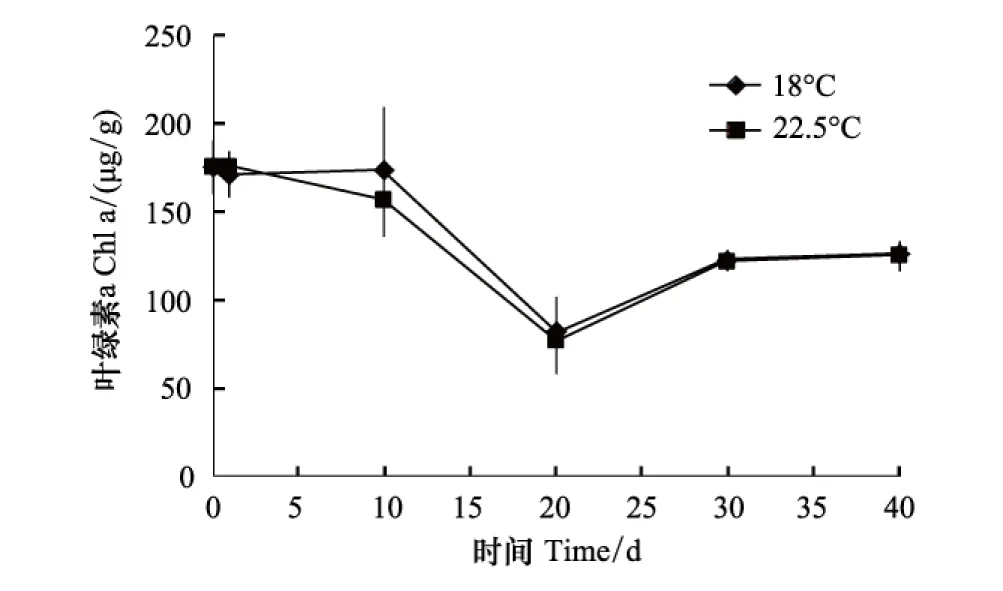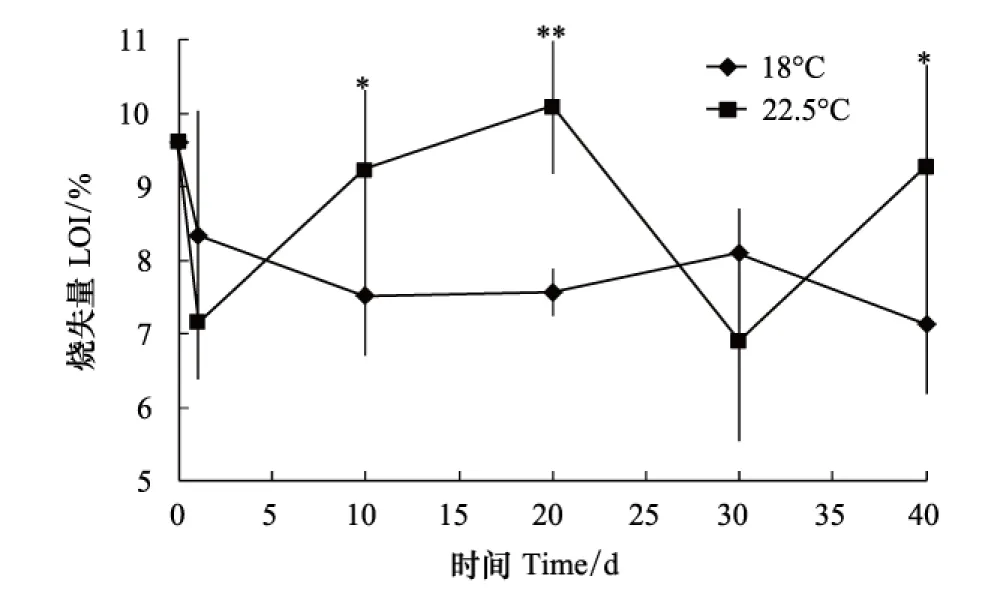升温对超富营养型浅水湖泊沉积物营养盐动态迁移的影响
李庚辰, 刘足根, 张 敏,*, 李 娟, 皮 坤, 熊 鹰, 徐 军
1 华中农业大学水产学院, 武汉 430070 2 江西省环境保护科学研究院, 南昌 330029 3 中国科学院水生生物研究所, 武汉 430072
升温对超富营养型浅水湖泊沉积物营养盐动态迁移的影响
李庚辰1, 刘足根2, 张 敏1,*, 李 娟1, 皮 坤1, 熊 鹰1, 徐 军3
1 华中农业大学水产学院, 武汉 430070 2 江西省环境保护科学研究院, 南昌 330029 3 中国科学院水生生物研究所, 武汉 430072

升温; 富营养化湖泊; 沉积物-水界面; 营养盐; 动态迁移
营养盐是湖泊生态系统中重要的化学物质,是湖泊生态系统中生物生长所必须的最重要的营养元素,也是湖泊生态系统的初级生产力和食物链基础。过量的氮、磷等营养物质进入湖泊水体,会使得藻类等水生生物异常繁殖,水体透明度和溶解氧发生变化,加速水体老化,从而使水体的生态系统和生态功能受到障碍、破坏[1]。

磷是浮游生物的主要营养要素,在生物活动中有重要作用,是生产力的主要限制因素之一[7- 8]。水中的磷可分为溶解态和悬浮态两类,目前对于自然状态下水体沉积物吸收、释放磷的研究已经进行了很多[9- 11],沉积物释放磷元素,取决于不溶性磷酸盐(主要是钙盐、铝盐和铁盐)重新溶解的环境条件,大量研究表明,水体中磷释放过程同样受到多种环境与生物因素的影响[12]。一般认为,溶解氧能够通过影响Fe2+—Fe3+化学反应,进而影响Fe3+与磷酸盐的结合,使湖泊生态系统在好氧状态下能促进磷的吸附,而厌氧状态下则加速沉积物中磷的释放[13];有研究表明,沉积物磷释放量与pH值呈“U”型线性相关,即pH值在中性范围时释磷量最小,在酸性和碱性条件下能够提高磷的释放量[14];扰动使表层沉积物再悬浮,增加沉积物反应界面,同时也加速了沉积物间隙水中磷的释放,但扰动的影响对磷的释放只是短期的有限效应[15]。
环境温度改变亦会影响水体中氮磷等营养物质的动态迁移特征。温度可以通过改变微生物活性而抑制或加速沉积物中不同形式氮的释放速率,许多研究表明,湖泊沉积物释放氮的速率均呈现出夏季最大、冬季较少的特征[16];环境温度升高,沉积物中的微生物活性增强,使水体环境由氧化状态向还原状态转化,有利于Fe3+的还原,加速沉积物中铁结合磷的释放[17- 18]。因此,了解全球变暖背景下温度升高对浅水湖泊沉积物-水界面营养物质动态迁移的特征具有十分重要的意义。
联合国政府间气候变化专门委员会(IPCC)第四次评估报告显示:在过去的一个世纪,全球地表温度升高大约0.74 ℃,并且在未来的100a升温幅度将达到3—5 ℃[19-20]。在湖泊生态系统中,春季气温变暖会使湖泊冰盖融化的时间提前[21],水温升高,部分湖泊垂直方向上的热分层现象提前出现[22],浮游植物群落数量峰值在春季提前出现,硅藻逐渐成为优势种,同时影响到其与浮游动物之间的营养关系[23]。对湖泊中生长速度较快、生长周期较短的浮游动物(如水蚤)来说,春季气温变暖对它们的繁殖期产生显著影响,从而使其生长受到限制,种群数量逐渐减少[24]。一些溯河产卵的鱼类由于春季气温变暖水温升高,春季洄游的时间相对提前[25]。湖泊沉积物是水体营养物质的主要宿体,是流域上物质搬运的最后归宿地,气候变暖会加剧沉积物中营养物质矿化的分解与释放[26]。因此,春季物候的改变能够更好地反映气候变化,与此同时,一些研究表明,夏季温度升高也会对湖泊生态系统产生多方面的影响[27]。
长江中下游地区是我国浅水湖泊比较集中的地区,且该地区亦是我国富营养化湖泊分布的主要地区[28- 29]。在工业化以前,其营养状态就处于中营养和富营养之间,但是,上世纪中期以后,伴随着经济发展的加快,湖泊快速趋于富营养化,人类活动的影响导致的沉积物和水体中的营养盐含量增加可达2—3 倍以上,沉积物中的其他指标,如氮、碳同位素含量、重金属元素含量也都指示着同样的变化趋势[30],同时,徐颖等研究发现,在只考虑温室气体增加的条件下,2100 年整个长江中下游地区地表温度平均升高幅度约为4.5 ℃,高于全球平均水平[31]。因此,本实验以重度富营养化的南湖为研究区域,于2012 年3 月24 日至5 月4 日在光照培养箱内模拟该地区春季气候变暖趋势,重点关注升温情况下沉积物-水界面不同形态氮磷的变化特征,旨在揭示气候变暖对重度富营养水平湖泊沉积物-水界面营养盐物质动态释放的影响,为进一步研究气候变暖趋势下,湖泊生态系统的响应机制奠定基础。
1 研究区域与研究方法
1.1 研究地点概况
武汉市南湖(30°30′N;121°21′E)属长江中游浅水湖泊,面积5.5 km2,平均水深1.6 m。近十几年来,由于城市的迅速发展和湖泊周边的地产开发,南湖沿岸区域人口突破30 万,仍呈增长趋势,大量生活污水流入湖中,加速了水体的富营养化[32- 33]。邱炳文等[34]研究表明,南湖营养程度有1982 年的中营养上升至1998 年的重富营养水平,16 年间上升了3 个营养级别。近几年有关武汉南湖的研究发现,武汉南湖水体中各营养盐浓度都有了较大的增长,总氮的平均浓度已经达到12.66 mg/L,硝态氮的平均浓度为1.08 mg/L,氨氮的平均浓度为0.83 mg/L,亚硝态氮的平均浓度为0.24 mg/L;水体总磷和正磷酸盐的平均浓度分别为0.24 mg/L和0.03 mg/L[35]。
1.2 实验材料
2012 年3 月18 日在武汉市南湖敞水区水深1.5—2.0 m处,用彼得森采泥器采集表层沉积物样品,经40 目筛网过滤,静置后虹吸管除去上覆水,将底泥混合均匀后一小部分冷冻保存,用于营养盐及其他指标初始值的分析,其余底泥分装入12 个底部直径10.2 cm,敞口直径12.8 cm、高9.0 cm的圆柱形塑料容器,每容器装入沉积物200 mL,沉积物高度约2.6 cm。采集南湖表层湖水,经20 mm孔径筛绢过滤,每容器放入过滤后的湖水700 mL。
1.3 实验设计与实验温度的确定

图1 近60 年武汉市年平均气温的变化趋势
根据中国地面国际交换站武汉市气候资料年值数据,与全球气候变暖趋势类似,近60 年来武汉的年平均气温呈现显著上升趋势(图1)。春季(3—5 月)的平均气温数据采用2000—2010 年3—5 月气温的平均值,近10 年武汉地区春季的平均气温为18 ℃,在只考虑温室气体作用的影响下,已有研究预测本地区气温在本世纪末将升高约4.5 ℃[31]。因此,本实验设置了两个温度处理:18 ℃(近10 年春季平均气温)和22.5 ℃(预测本地区本世纪末气温),每个处理6 个平行,置于光照培养箱中,光照强度3 级,白天/黑夜为12 h/12 h。
1.4 模拟实验和分析方法

每个指标所得到的数据,在Excel中将相同时间的不同处理进行单因素方差分析,同时对一些指标进行线性回归分析以探究其随时间的变化趋势。
2 实验结果

图2 水体中三种形态氮的浓度变化
2.2 水体o-P和TP的变化
如图3所示,升温对水体磷浓度的影响较大,水体o-P初始含量均为0.10 mg/L,之后22.5 ℃处理水体中o-P呈现上升趋势,到第13天升至0.55 mg/L达到峰值,自第26天开始相对稳定在0.27 mg/L左右。18 ℃处理组最低值出现在第13天,为0.07 mg/L,从13d至22d出现缓慢上升,自第22天开始相对稳定在0.22 mg/L左右。除实验初期两组无显著差异外,其余各时段22.5 ℃处理的水体中o-P的含量显著高于18 ℃处理(P<0.01)。两处理组水体中的TP初始含量均为0.37 mg/L,22.5 ℃处理组最高值为0.74 mg/L同样出现在第13天,从实验开始至第13天水体的TP明显增加,第25天开始保持相对稳定,含量约为0.36 mg/L。18 ℃处理组最低值出现在第10天,含量为0.18 mg/L,第25天开始相对稳定在0.30 mg/L左右。单因素方差分析表明,大多数时间点,22.5 ℃处理水体的TP显著高于18 ℃(P<0.05)。

图3 水体中o-P和TP的浓度变化
2.3 TNs和TPs的变化
如图4所示,两个处理组TNs的含量,除第20天含量产生了差异(P<0.05),其余各时间TNs含量均无显著性差异,然而线性回归分析显示,两处理组TNs均具有显著下降的趋势(P<0.05),其中,18 ℃处理组的下降趋势更加显著(P=0.03)。同样,系统中TPs的含量差异不大,只有实验第40天时产生了显著差异(P<0.01),线性回归显示两处理组的TPs含量在整个实验阶段内没有显著变化的趋势,但如图4所示18 ℃处理组呈现出了一种先上升,后下降的变化规律,而22.5 ℃处理组的含量基本维持在了原水平。

图4 TNs与TPs含量的变化
2.4 沉积物Chl a的变化
如图5所示,两处理组沉积物Chl a含量在整个实验阶段没有显著性差异,整体呈现出先下降后上升的规律,实验初始值为175.5 mg/g,在实验第20天沉积物Chl a含量下降到最低,分别为77.2 mg/g(22.5 ℃)与82.3 mg/g(18 ℃),最终第40天沉积物Chl a含量分别为125.2 mg/g与126.4 mg/g。
2.5 沉积物LOI的变化
实验阶段中期,两处理组的烧失量(LOI)大部分时间22.5 ℃要高于18 ℃(图6),初始值9.6%,回归分析显示两处理组的沉积物烧失量没有显著上升或下降的趋势,但22.5 ℃的处理组在整个实验阶段的波动较大,最终实验第40天依然高于18 ℃处理组。

图5 沉积物Chl a含量的变化

图6 沉积物LOI的变化
3 讨论
3.1 升温对系统沉积物磷动态迁移的影响

3.2 升温对系统沉积物氮动态迁移的影响


4 结论
通过室内模拟控制实验可以初步得到以下结论:(1)在超富营养型浅水湖泊中,底层水温度的升高能够显著促进湖泊沉积物中磷元素的释放,使水体当中的磷浓度显著升高,从而加剧水体富营养化的风险;(2)由于反硝化作用与底栖生物利用两个原因,造成本实验模拟系统中氮的损失,本实验系统中未观察到升温对沉积物中氮的动态迁移产生显著影响,但温度的升高对于超富营养型浅水湖泊沉积物中氮元素营养盐动态迁移的影响依然有待进一步实验论证。
[1] 李文霞, 冯海艳, 杨忠芳, 阮晓红. 水体富营养化与水体沉积物释放营养盐. 地质通报, 2006, 25(5): 602- 608.
[2] 吴丰昌, 万国江, 黄荣贵. 湖泊沉积物——水界面营养元素的生物地球化学作用和环境效应: Ⅰ.界面氮循环及其环境效应. 矿物学报, 1996, 16(4): 403- 409.
[3] 于军亭, 张帅, 张志斌, 王立鹏, 魏垒垒, 谭晓波. 环境因子对浅水湖泊沉积物中氮释放的影响. 山东建筑大学学报, 2000, 25(1): 58- 61.
[4] 姜爱霞. 水环境氮污染的机理和防治对策. 中国人口·资源与环境, 2000, 10(S1): 75- 76.
[5] 付春平, 钟成华, 邓春光. pH与三峡库区底泥氮磷释放关系的试验. 重庆大学学报: 自然科学版, 2004, 27(10): 125- 127.
[6] Reddy K R, Fisher M M, Ivanoff D. Resuspension and diffusive flux of nitrogen and phosphorus in a hypereutrophic lake. Journal of Environmental Quality, 2004, 25(1): 363- 371.
[7] Gibson C E. Nutrient limitation. Journal of the Water Pollution Control Federation, 1971, 43: 2436- 2440.
[8] Dorich R A, Nelson D W, Sommers L E. Availability of phosphorus to algae from eroded soil fractions. Agriculture, Ecosystems and Environment, 1984, 11(3): 253- 264.
[9] Detenbeck N E, Brezonik P L. Phosphorus sorption by sediments from a soft-water seepage lake. 2. Effects of pH and sediment composition. Environmental Science & Technology, 1991, 25(3): 403- 409.
[10] Yao W S, Millero F J. Adsorption of phosphate on manganese dioxide in seawater. Environmental Science & Technology, 1996, 30(2): 536- 541.
[11] Zhao H S, Stanforth R. Competitive adsorption of phosphate and arsenate on goethite. Environmental Science & Technology, 2001, 35(24): 4752- 4757.
[12] 陈田耕. 关于磷自沉积物的释放. 环境科学丛刊, 1988, 9(1): 36- 42.
[13] Gomez E, Dunllon C, Rofes G, Picot B. Phosphate adsorption and release from sediments of brackish lagoons: pH, O2and loading influence. Water Research, 1999, 33(10): 2437- 2447.
[14] 王晓蓉, 华兆哲, 徐菱, 赵闯, 吴重华. 环境条件变化对太湖沉积物磷释放的影响. 环境化学, 1996, 15(1): 15- 19.
[15] 张路, 范成新, 秦伯强, 杨龙元. 模拟扰动条件下太湖表层沉积物磷行为的研究. 湖泊科学, 2001, 13(1): 35- 42.
[16] 范成新, 张路, 秦伯强, 胡维平, 高光, 王建军. 太湖沉积物-水界面生源要素迁移机制及定量化——1.铵态氮释放速率的空间差异及源-汇通量. 湖泊科学, 2004, 16(1): 10- 20.
[17] Eckert W, Nishn A, Parparova R. Factors regulating the flux of phosphate at the sediment-water interface of a subtropical calcareous lake: A simulation study with intact sediment cores. Water, Air, & Soil Pollution, 1997, 99(1/4): 401- 409.
[18] Gonsiorczyk T, Casper P, Koschel R. Variations of phosphorus release from sediments in stratified lakes. Water, Air, & Pollution, 1997, 99(1/4): 427- 434.
[19] IPCC. Climate Change 2007: the physical sciences basis // Parry M L, Canziani O F, Palutikof J P, Linden P J, Hanson C E, eds. Contribution of Working Group Ⅰ to the Fourth Assessment Report of the Intergovernmental Panel on Climate Change. Cambridge, UK: Cambridge University, 2007: 7- 22.
[20] Houghton J. The science of global warming. Interdisciplinary Science Reviews, 2001, 26(4): 247- 257.
[21] Wynne R H, Lillesand T M. Satellite observation of lake ice as a climate indicator: initial results from statewide monitoring in Wisconsin. Photogrammetric Engineering and Remote Sensing, 1993, 59(6): 1023- 1031.
[22] Boehrer B, Schultze M. Stratification of lakes. Reviews of Geophysics, 2008, 46(2): 745- 722.
[23] Winder M, Schindler D E. Climatic effects on the phenology of lake processes. Global Change Biology, 2004, 10(11): 1844- 1856.
[24] Seebens H, Straile D, Hoegg R. Population dynamics of a freshwater calanoid copepod: Complex responses to changes in trophic status and climate variability. Limnology & Oceanography, 2007, 52(6): 2364- 2372.
[25] Quinn T P, Adams D J. Environmental changes affecting the migratory timing of American shad and sockeye salmon. Ecology, 1996, 77(4): 1151- 1162.
[26] Jeppesen E, Kronvang B, Meerhoff M, Søndergaard M, Hasen K M, Andersen H E, Lauridsen T L, Liboriussen L, Beklioglu M, Özen A, Olesen J E. Climate change effects on runoff, catchment phosphorus loading and lake ecological state, and potential adaptations. Journal of Environmental Quality, 2009, 38(5): 1930- 1941.
[27] 卡尔夫. 湖沼学: 内陆水生态系统. 古滨河, 刘正文, 李宽意, 等, 译. 北京: 高等教育出版社, 2011: 176- 178.
[28] 秦伯强. 长江中下游浅水湖泊富营养化发生机制与控制途径初探. 湖泊科学, 2002, 14(3): 193- 202.
[29] 蔡永久, 姜加虎, 张路, 陈宇伟, 龚志军. 长江中下游湖泊大型底栖动物群落结构及多样性. 湖泊科学, 2010, 22(6): 811- 819.
[30] 秦伯强, 朱广伟. 长江中下游地区湖泊水和沉积物中营养盐的赋存、循环及其交换特征. 中国科学D辑, 2005, 35(S2): 1- 10.
[31] 徐影, 丁一汇, 赵宗慈. 长江中下游地区21世纪气候变化情景预测. 自然灾害学报, 2004, 13(1): 25- 31.
[32] 杨学芬, 熊邦喜, 杨明生. 武汉南湖水体及沉积物不同形态磷的季节变化. 应用生态学报, 2008, 19(9): 2029- 2034.
[33] 王银东, 熊邦喜, 杨学芬. 用大型底栖动物对武汉南湖水质的生物学评价. 环境污染与防治, 2006, 28(4): 312- 314.
[34] 邱炳文, 周勇, 周敏, 李学垣. 武汉市南湖富营养化现状、趋势及其综合整治对策. 华中农业大学学报, 2000, 19(4): 350- 352.
[35] 杨学芬. 武汉南湖营养盐动态及重金属污染的研究 [D]. 武汉: 华中农业大学, 2010: 8- 12.
[36] 金相灿. 湖泊富营养化调查规范 (第二版). 北京: 中国环境科学出版社, 1990: 55- 60.
[37] 吴以平, 刘晓收. 青岛湾潮间带沉积物中叶绿素的分析. 海洋科学, 2005, 29(11): 8- 12.
[38] 鲁如坤. 土壤农业化学分析方法. 北京: 中国农业科技出版社, 2002: 166- 168.
[39] 易文利. 湖泊沉积物中有机质含量对释放磷的影响. 科学技术与工程, 2011, 11(26): 6401- 6404.
[40] 李高金, 周杰. 环境因子对南四湖沉积物中磷释放的影响. 农业环境科学学报, 2006, 25(S2): 653- 656.
[41] 潘成荣, 张之源, 叶琳琳, 郑志侠, 汪家权. 环境条件变化对瓦埠湖沉积物磷释放的影响. 水土保持学报, 2006, 20(6): 148- 152.
[42] 汪家权, 孙亚敏, 钱家忠, 巫建光, 潘天声. 巢湖底泥磷的释放模拟实验研究. 环境科学学报, 2002, 22(6): 738- 743.
[43] 范成新, 张路, 秦伯强, 王苏民, 胡维平, 张琛. 风浪作用下太湖悬浮态颗粒物中磷的动态释放估算. 中国科学D辑, 2003, 33(8): 760- 780.
[44] 吴根福, 吴雪昌, 金承涛, 宣晓东, 李梅姿. 杭州西湖底泥释磷的初步研究. 中国环境科学, 1998, 18(2): 107- 110.
[45] 韩沙沙, 温琰茂. 富营养化水体沉积物中磷的释放及其影响因素. 生态学杂志, 2004, 23(2): 98- 101.
[46] 刘子婷, 余俊清, 张保华, 蔡伟, 张立莎. 烧失量分析在湖泊沉积与环境变化研究中的应用. 盐湖研究, 2006, 14(2): 67- 72.
[47] 张新明, 李华兴, 刘远金. 磷酸盐在土壤中吸附于解吸研究进展. 土壤与环境, 2001, 10(1): 77- 80.
[48] Wetzel R G. Benthic algae and nutrient cycling in lentic freshwater systems // Stevenson R J, Bothwell M L, Lowe R L, eds. Algal Ecology: Freshwater Benthic Ecosystems. San Diego: Academic Press, 1996: 642- 667.
[49] 李万会, 丁平兴. 滩涂沉积物中叶绿素a浓度与沉积特性的关系. 华东师范大学学报: 自然科学版, 2007, (4): 26- 33.
[50] Hansson L A. Effects of competitive interactions on the biomass development of planktonic and periphytic algae in lakes. Limnology & Oceanography, 1988, 33(1): 121- 128.
[51] Pauer J J, Auer M T. Nitrification in the water column and sediment of a hypereutrophic lake and adjoining river system. Water Research, 2000, 34(4): 1247- 1254.
[52] 曾巾, 杨柳燕, 肖琳, 尹大强, 秦伯强. 湖泊氮素生物地球化学循环及微生物的作用. 湖泊科学, 2007, 19(4): 382- 389.
[53] 刘峰, 高云芳, 王立欣, 李秀启, 师吉华, 客涵, 王亚楠, 冷春梅, 王芳, 董双林. 水域沉积物氮磷赋存形态和分布的研究进展. 水生态学杂志, 2011, 32(4): 137- 144.
[54] 范成新, 相畸守弘. 好氧和厌氧条件对霞浦湖沉积物——水界面氮磷交换的影响. 湖泊科学, 1997, 9(4): 337- 342.
[55] Gu B H, Alexander V. Dissolved nitrogen uptake by a cyanobacterial bloom (Anabaenaflos-aquae) in a Subartic Lake. Applied and Environmental Microbiology, 1993, 59(2): 422- 430.
[56] Seitzinger S P. Denitrification in freshwater and coastal marine ecosystems: ecological and geochemical significance. Limnology & Oceanography, 1988, 33(4 Part 2): 702- 724.
[57] Robertson L A, Van Neil E W J, Torremans R A, Kuenen J G. Simultaneous nitrification and denitrification in aerobic chemostat cultures ofThiosphaerapantotropha. Applied and Environmental Microbiology, 1988, 54(11): 2812- 2818.
[58] Carter J P, Hsiao Y H, Spiro S, Richardson D J. Soil and sediment bacteria capable of aerobic nitrate respiration. Applied and Environmental Microbiology, 1995, 61(8): 2852- 2858.
[59] 丁爱中, 傅家谟, 盛国英. 好氧生物反硝化反应的实验证据. 科学通报, 2000, 45(S): 2779- 2782.
[60] 吕锡武, 李锋, 稻森悠平, 水落元之. 氨氮废水处理过程中的好氧反硝化研究. 给水排水, 2000, 26(4): 17- 20.
[61] Mariotti A, Landreau A, Simon B.15N isotope biogeochemistry and natural denitrification process in groundwater: application to the chalk aquifer of northern France. Geochimica et Cosmochimica Acta, 1988, 52(7): 1869- 1878.
[62] 杨龙元, Gardner W S. 休伦湖Saginaw湾沉积物反硝化率的测定及其时空特征. 湖泊科学, 1998, 10(3): 548- 553.
[63] 马沛明, 况琪军, 刘国祥, 胡征宇. 底栖藻类对氮、磷去除效果研究. 武汉植物学研究, 2005, 23(5): 465- 469.
[64] 姚晓, 山口一岩, 邹立, 高会旺, 郭新宇. 黄河三角洲南部潮间带沉积环境对底栖叶绿素a分布特征的影响. 生态学杂志, 2010, 29(9): 1762- 1769.
[65] 林慧, 苏玉萍, 庄一延, 钟厚璋, 林佳, 金华. 福建省山仔水库和杜塘水库沉积物叶绿素a比较研究. 亚热带资源与环境学报, 2011, 6(4): 42- 48.
[66] 杨明生. 武汉市南湖大型底栖动物群落结构与生态功能的研究 [D]. 武汉: 华中农业大学, 2009: 16- 18.
A preliminary study of effects of warming on the nutrients dynamic in sediment of hypereutrophic shallow lake
LI Gengchen1, LIU Zugen2, ZHANG Min1,*, LI Juan1, PI Kun1, XIONG Ying1, XU Jun3
1CollegeofFisheries,HuazhongAgriculturalUniversity,Wuhan430070,China2JiangxiAcademyofEnvironmentalProtectionSciences,Nanchang330029,China3InstituteofHydrobiology,ChineseAcademyofSciences,Wuhan430072,China
It is now accepted that human-induced climate change is unavoidable. On average, global surface temperatures have increased by about 0.74 ℃ over the past 100 years with the majority of the increase (0.55 ℃) occurring over the past 30 years. Marked changes may be expected to occur in the global climate during this century. Temperature increase, although only one of several related climate changes, is the key variable of change and one that pervades almost all biological processes. All ecosystems will therefore be affected to some extent by global warming and predicting potential effects on the ecosystems is of great importance for ecology and management. Lake ecosystems are vital resources for aquatic wildlife and human needs, and any alteration of their environmental quality and water renewal rates has wide-ranging ecological and societal implications. However, lakes have always been subject to the impacts of climate change, and natural climate variations in the past have been one of the main reasons that lakes are ephemeral features of the landscape. The sediment in lakes typically has high concentrations of nutrients and organic matter, and hosts a biologically active autotrophic-heterotrophic community. Thus, knowledge of the warming effects on nutrients dynamic in sediment is in urgent need. In the present study, an indoor microcosm system was set up to explore the effects of warming on the nutrients dynamic in sediment of a hypereutrophic shallow lake, Lake Nanhu. Sieved sediment cores were incubated under laboratory conditions, the experimental temperature regimes consisted of decadal spring average of Wuhan city (18 ℃) and an elevated regime with 4.5 ℃ difference from that at baseline (22.5 ℃). The contents of orthophosphate and total phosphorus in the water under the ambient temperature of 22.5 ℃ was significantly higher than those of 18 ℃ during the middle stage of the experiment, which indicated that warming accelerated the release of phosphorus from the sediment into water and the increase of the phosphorus content in the water would further increase the eutrophication. The concentration of the nitrate nitrogen in water raise rapidly accompany with the ammonia nitrogen concentration decreasing fast in the beginning of the experiment. Nevertheless, the contents of total nitrogen in water under two different temperature conditions were not significantly different from each other. The concentrations of total nitrogen in water and sediment were continuously declining at both conditions in all the experimental phases, which may indicate the denitrification and the benthic biological absorption in this experiment system. The total phosphorus content in sediment, loss on ignition of sediment, an indicator for loss of organic matter, and the chlorophyll a in the sediments were not significantly affected by the elevated temperature in this experiment system. In conclusion, warming may profoundly affect the phosphorus dynamics, but no obvious impact on the nitrogen dynamics in sediment.
warming; eutrophic lake; sediment-water interface; nutrients; dynamics
国家自然科学基金资助项目(31200359); 国家水体污染控制与治理科技重大专项课题子课题(2012ZX07501001-06); 公益性行业(农业)科研专项(201203083)
2013- 09- 10;
2014- 07- 02
10.5846/stxb201309102244
*通讯作者Corresponding author.E-mail: zhm7875@mail.hzau.edu.cn
李庚辰, 刘足根, 张敏, 李娟, 皮坤, 熊鹰, 徐军.升温对超富营养型浅水湖泊沉积物营养盐动态迁移的影响.生态学报,2015,35(12):4016- 4025.
Li G C, Liu Z G, Zhang M, Li J, Pi K, Xiong Y, Xu J.A preliminary study of effects of warming on the nutrients dynamic in sediment of hypereutrophic shallow lake.Acta Ecologica Sinica,2015,35(12):4016- 4025.

